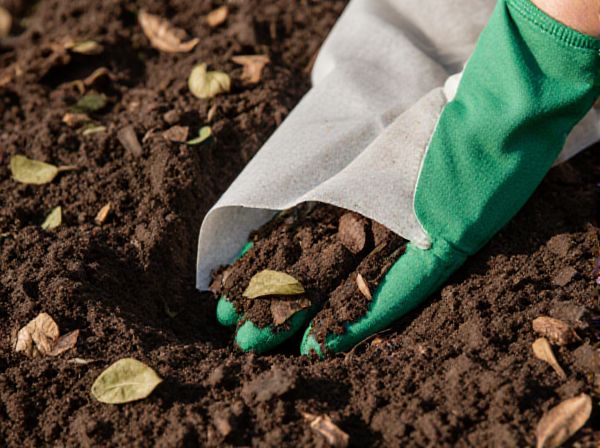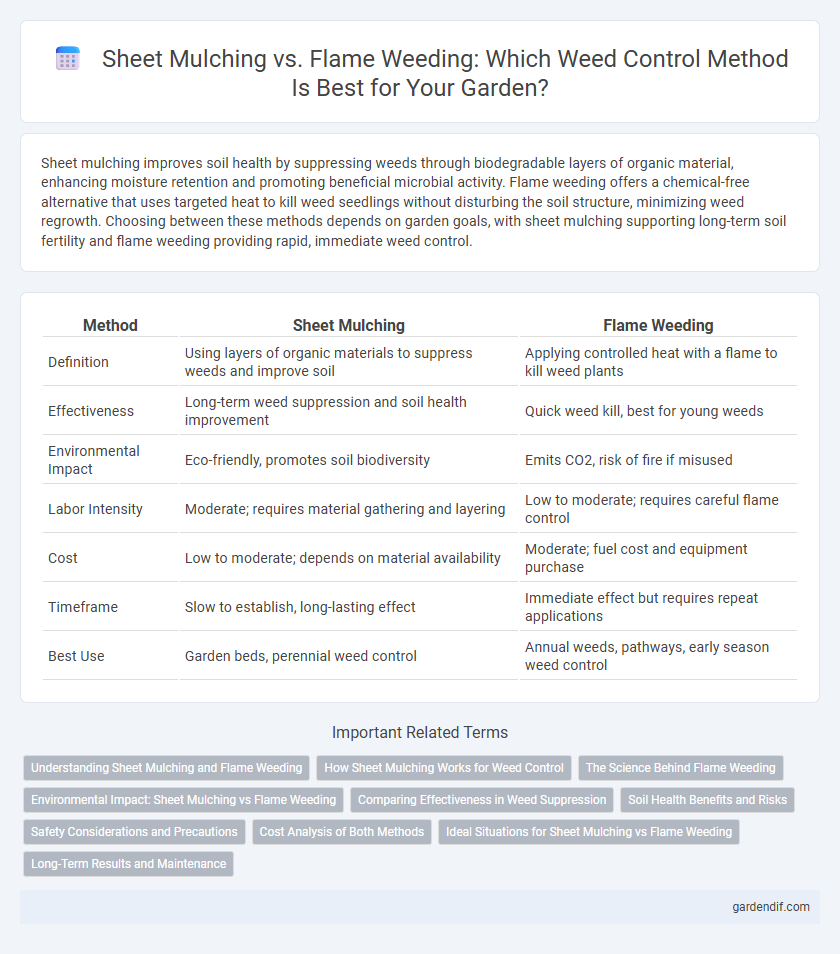
Sheet mulching vs Flame weeding Illustration
Sheet mulching improves soil health by suppressing weeds through biodegradable layers of organic material, enhancing moisture retention and promoting beneficial microbial activity. Flame weeding offers a chemical-free alternative that uses targeted heat to kill weed seedlings without disturbing the soil structure, minimizing weed regrowth. Choosing between these methods depends on garden goals, with sheet mulching supporting long-term soil fertility and flame weeding providing rapid, immediate weed control.
Table of Comparison
| Method | Sheet Mulching | Flame Weeding |
|---|---|---|
| Definition | Using layers of organic materials to suppress weeds and improve soil | Applying controlled heat with a flame to kill weed plants |
| Effectiveness | Long-term weed suppression and soil health improvement | Quick weed kill, best for young weeds |
| Environmental Impact | Eco-friendly, promotes soil biodiversity | Emits CO2, risk of fire if misused |
| Labor Intensity | Moderate; requires material gathering and layering | Low to moderate; requires careful flame control |
| Cost | Low to moderate; depends on material availability | Moderate; fuel cost and equipment purchase |
| Timeframe | Slow to establish, long-lasting effect | Immediate effect but requires repeat applications |
| Best Use | Garden beds, perennial weed control | Annual weeds, pathways, early season weed control |
Understanding Sheet Mulching and Flame Weeding
Sheet mulching involves layering organic materials like cardboard and compost to suppress weeds, improve soil health, and retain moisture effectively. Flame weeding uses propane-fueled flames to kill weeds by rapidly heating plant cells, providing a chemical-free option for weed control. Both methods offer sustainable alternatives to herbicides, with sheet mulching promoting soil fertility and flame weeding delivering quick weed destruction without soil disturbance.
How Sheet Mulching Works for Weed Control
Sheet mulching controls weeds by creating a thick barrier of organic materials such as cardboard, newspaper, and mulch that blocks sunlight, preventing weed seeds from germinating. This method suppresses weed growth naturally while gradually enriching the soil as the organic layers decompose. Sheet mulching also improves moisture retention and soil structure, promoting healthier plant growth without the need for chemical herbicides.
The Science Behind Flame Weeding
Flame weeding utilizes intense heat to disrupt plant cell structure, causing rapid water vaporization inside weed tissues and leading to cell rupture and death, effectively controlling weed growth without chemicals. This method targets the weed's outer cells and requires precise temperature control, typically between 482degF to 1300degF, to maximize efficacy while minimizing damage to soil microorganisms and surrounding plants. In contrast, sheet mulching suppresses weeds by blocking sunlight and improving soil health over time but lacks the immediate and selective destruction capabilities offered by flame weeding's thermal impact.
Environmental Impact: Sheet Mulching vs Flame Weeding
Sheet mulching enhances soil health by adding organic matter that supports beneficial microbes and reduces weed growth naturally, while flame weeding relies on high-temperature exposure to kill weeds, emitting carbon dioxide and potentially harming soil microbiota. The organic decomposition in sheet mulching improves moisture retention and carbon sequestration, contrasting with flame weeding's risk of increasing soil erosion and releasing greenhouse gases. Sustainable weed management benefits from the eco-friendly, nutrient-enriching properties of sheet mulching compared to the energy-intensive and chemical-free but emission-producing flame weeding.
Comparing Effectiveness in Weed Suppression
Sheet mulching provides long-term weed suppression by blocking sunlight and improving soil health through organic matter decomposition, effectively smothering seeds and roots beneath layers of cardboard and mulch. Flame weeding offers immediate weed control by using intense heat to damage plant cells, but it may require repeated applications to manage persistent or deep-rooted weeds. For sustained weed suppression, sheet mulching outperforms flame weeding by promoting a healthier soil ecosystem and reducing weed seed germination rates over time.
Soil Health Benefits and Risks
Sheet mulching enhances soil health by improving moisture retention, increasing organic matter, and fostering beneficial microbial activity, which supports sustainable weed control. Flame weeding offers immediate weed destruction but poses risks to soil microorganisms and organic matter, potentially compromising soil structure and nutrient cycling over time. Prioritizing sheet mulching can lead to long-term soil vitality, while flame weeding should be used cautiously to minimize soil damage.
Safety Considerations and Precautions
Sheet mulching offers a safe, chemical-free weed control method by smothering weeds with layers of organic materials, reducing fire hazards and minimizing risks to pets and children. Flame weeding requires careful handling of propane torches and adherence to strict fire safety regulations to prevent accidental burns, wildfires, and damage to nearby plants. Employing protective gear and maintaining a clear, damp area around the treatment zone are essential precautions to ensure safety during flame weeding.
Cost Analysis of Both Methods
Sheet mulching involves upfront costs for biodegradable materials like cardboard and mulch but offers long-term weed suppression with minimal maintenance expenses. Flame weeding requires investment in fuel and equipment, with recurring costs tied to frequent applications to manage persistent weed growth effectively. Comparing total expenses, sheet mulching proves more cost-effective over time due to reduced labor and material replacement, while flame weeding suits smaller areas with quicker but less durable results.
Ideal Situations for Sheet Mulching vs Flame Weeding
Sheet mulching is ideal for nutrient-poor soils and areas requiring long-term weed suppression, as it enriches soil organic matter while blocking sunlight to inhibit weed growth. Flame weeding is most effective in well-established garden beds or pathways where rapid, non-chemical weed control is needed without disturbing the soil structure. Combining sheet mulching with flame weeding can optimize weed management by reducing seed banks and enhancing soil health in diverse garden settings.
Long-Term Results and Maintenance
Sheet mulching promotes sustainable weed control by enriching soil health and suppressing weed growth over multiple growing seasons, reducing the need for frequent intervention. Flame weeding offers immediate weed destruction but requires regular application to prevent regrowth and may damage beneficial soil organisms. Long-term maintenance favors sheet mulching due to its organic matter integration, which enhances soil structure and fertility while minimizing ongoing labor.
Sheet mulching vs Flame weeding Infographic

 gardendif.com
gardendif.com